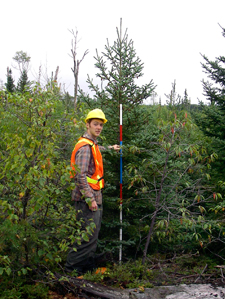Forest monitoring
How forest management operations in Ontario are monitored and audited to assess compliance, and evaluate progress and results.
Monitoring
The ministry monitors Crown forests by collecting and studying information about forest management activities to:
- ensure forest operations follow approved plans and standards
- verify sustainable forest management on each management unit
- determine how effective forest management activities are in producing results of the approved plans
- assess the effects of forest management and major forest disturbances on the long-term health of the forest
- continuously improve forest management direction by making updates and knowledge based on monitoring results
The ministry uses the results of this information to report on the status of forest management activities and the health of Ontario’s forests to the people of Ontario.
Forest operations compliance
Under this program, we determine whether forest operations on Crown lands are following the laws, approved plans and operational practices.
Forest management companies must:
- carry out self-monitoring (inspecting and reporting), training and education
- provide reports of forest operations inspections to the ministry
The ministry:
- provides policy direction for forest operations compliance
- maintains the Forest Operations Information Program, a web-based system to document inspections
- monitors and audits
- ensures that forest operations conducted on Crown land conform to government standards, guidelines and rules and confirms action is taken to correct negative impacts to the forest should they occur
Copies of individual forest operations compliance inspection reports are available, upon request, from ministry’s local work centres.
Independent forest audits
Every 10 to 12 years, an Independent Forest Audit (IFA) takes place on each of the province’s management units to examine the performance of both the Sustainable Forest Licence (SFL) holder and the ministry in meeting their forest management responsibilities.

The ministry develops the audit process and the Forestry Futures Committee oversees how it is delivered. At least once every ten years the IFA process is reviewed to ensure it continues to be efficient and effective.
Audit process
-
Step 1: The ministry's Integration Branch selects auditors.
-
Step 2: Auditors collect evidence by reviewing documents, conducting interviews and by visiting certain sites (e.g. harvesting, regeneration, tending, road construction, water crossings) within forests. Auditors examine the forest management planning and operations of each management unit to determine if they have:
- followed provincial laws and approved direction and standards
- succeeded in achieving the planned results
- provided forest sustainability for the management unit
- met the conditions of the SFL
-
Step 3: If auditors have concerns about forest management activities, they present their findings to the forest company and/or the ministry.
-
Step 4: Auditors produce a report to document their findings.
-
Step 5: The licensee and/or the ministry create action plans to specify how they will change their activities to address the audit findings.
-
Step 6: The licensee and the ministry report on the completion of actions in management unit annual reports.
Audit resources:
Silviculture effectiveness monitoring
The ministry tracks forest regeneration activities and determines the results and effectiveness of those activities by:
- reporting regeneration activities each year
- tracking of regenerating forests
- assessing the regenerated forest
- examining the actual regeneration results against expected results

Success is measured 5–15 years after forest renewal activities are completed by:
- measuring trees on sample areas of the forest
- aerial surveys
- remote sensing (e.g. satellite imagery or aerial photography)
Forest managers can use information gathered from silviculture effectiveness monitoring to:
- prescribe activities needed to achieve the objective
- determine if it has reached the regeneration standard (Free-to-Grow)
- improve future plans or activities based on actual results
Download Silviculture Effectiveness Monitoring Manual (PDF)
Forest health monitoring
Records and monitors major factors (e.g., insects, diseases, severe weather) affecting forest health.

Forest health monitoring:
- detects, identifies and determines the extent of major forest disturbances
- determines the impact on forest values (e.g., wood supply, tourism)
- examines historical information and predicts the potential for future disturbances
Gathering information on forest health supports:
- planning forest management and pest management programs
- designing research projects, invasive species strategies, climate change programs
- evaluating forest sustainability and biodiversity